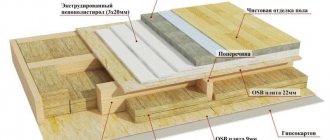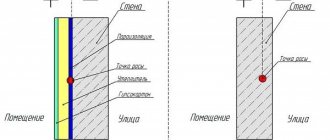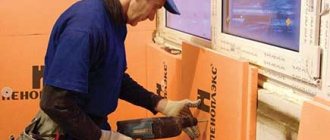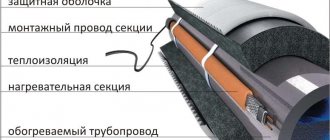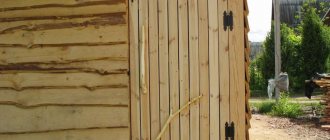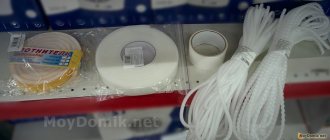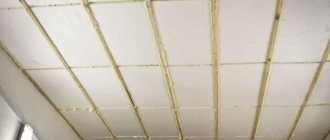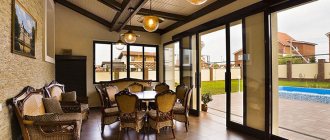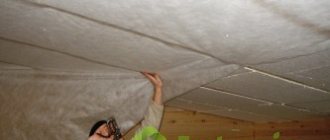Home kennel as a dog’s personal space
A doghouse in a room at home rather plays a decorative role and serves as a resting place. For animals of large breeds, it is advisable to equip flat beds, since a full-fledged house with a roof will take up a very large space.
For small decorative dogs weighing up to 15-20 kg, cute indoor kennels are often made from foam rubber, cardboard or thin plywood. A removable mattress is placed inside the kennel, which can be easily removed and washed as needed. A dog house in an apartment is usually covered with upholstery or decorative fabric that matches the interior.
The pet's place is located in a secluded corner, away from drafts. You should not place the house on the walkway, because it is inconvenient for both the household and the dog itself. It is best to set up a home kennel somewhere in the room, away from the hustle and bustle, but the kitchen or hallway is clearly not the best place.
Sometimes owners set up a dog house on the balcony. This design is justified in the warm season; the pet can stay in the fresh air for a long time. Almost the same requirements apply to it as to a street building, that is, it must be durable, waterproof and windproof.
In winter, a balcony kennel is usually not used. The exception is insulated loggias, where the kennel can stand both in winter and summer.
Why insulate the booth?
Some dog owners note that their dog is not afraid of cold weather. He can calmly lie in the snow in -30°C frost, chew a bone and be completely satisfied with his life. However, every dog should have its own cozy corner where it can relax. And it doesn’t matter whether the pet lives all year round in an apartment or on the street.
If a dog lives mainly outside the house, a warm undercoat gradually grows. The colder it gets, the warmer the dog's fur coat. If the dog lived in an apartment, but the owners decided to go to the country for the weekend, you should not leave him outside. The dog simply will not be able to adapt so quickly to being in the cold.
Large dogs retain body heat better, but they also need a comfortable kennel. If the dog is medium or small in size, the house should be very warm. Otherwise, the animal will catch a cold, you will have to go to the veterinarian and keep the dog at home.
Some owners cannot stay in the cottage all the time in winter. They leave the dog with a local watchman or ask neighbors to take care of their pet. In this case, the dog’s booth should be warm and cozy so that he does not feel homeless and lonely. He will know that the owners arranged this corner for him and left him to look after the house. Our regular reader Eduard.N faced this situation. He writes the following: “Tell me how to properly organize the wintering of a dog, the dog is aged (over 10 years old). We agreed with the watchman in the winter that he will come in to feed during the week.”

For an older dog, you need to select high-quality booth insulation. After all, the immunity of such animals is already weakened. If you plan to keep your dog outside in winter, the kennel must be insulated.
Constructions
A large selection of options allows you to choose the design of the kennel depending on the specific situation.
With a gable roof

The traditional gable roof is perhaps the most common option, found everywhere. The walls are made of wood, brick, frame. The roof is made of wooden panels and slate. In cold regions, the structure must be supplemented with an attic floor made of boards or plywood to minimize heat loss.
It is convenient to arrange a small closet under the gable roof, which will serve as a place to store ammunition, toys, and training equipment. One of the slopes is attached to the door hinges so that it can be raised if necessary. The angle of inclination of a gable roof can be varied from 5 to 60 degrees, but a roof with an angle between the slopes of about 40 degrees looks most beautiful.
With a pitched roof
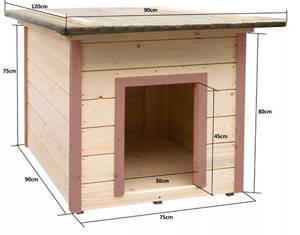
A shed roof is practically no different in its properties from a gable roof, and it is a little easier to make. The material used is the same as in the first option - tightly knit wooden panels, slate sheets. You should avoid roofs made of corrugated sheets or metal tiles, because iron gets hot in the summer and does not retain heat in the winter.
The slope of a lean-to kennel should be directed in the direction opposite to the entrance, so that water does not flow directly into the room during rain. The tilt angle should be at least 5-10 degrees. The wooden roof is additionally protected with roofing felt, slate, and thick plastic film.
With vestibule
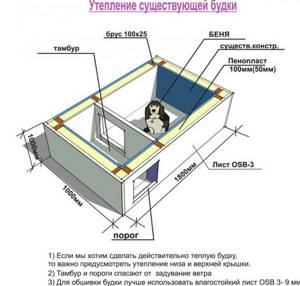
A two-room dog house is a very comfortable accommodation option. Thanks to the vestibule, the four-legged watchman can sit under the roof during bad weather, and sleep and relax in a second enclosed room. Such a kennel is much warmer than a one-room one, because the vestibule prevents the wind from blowing into the sleeping compartment. In northern regions with cold, long winters, a two-room insulated kennel is the best solution for keeping animals outside.
The frame of the booth is installed in such a way that the roof over the closed compartment can be raised to change the bedding, as well as periodic disinfection. The hole into the second compartment is positioned at an angle to the entrance to create an additional obstacle to the wind.
With canopy
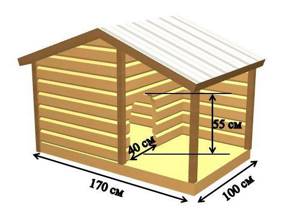
A booth with a veranda is not as comfortable as a two-room one. Such a shelter protects the four-legged pet well from rain, but not from wind, so if possible it is installed in a windproof area of the yard.
The roof and bottom of the dog house with a terrace are made to protrude from the side of the manhole. The size of the porch depends on the breed; it is designed so that the dog can comfortably fit there while lying down. As a rule, the veranda is half or slightly less of the total area of the structure.
If you approach the matter with imagination, a doghouse with a porch can turn into a real fairy-tale mansion and become a decoration of the site. A building with a painted or carved porch looks very nice.
Two-story
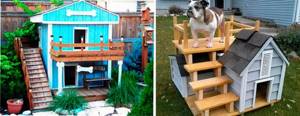
Two-story dog houses are more of an unusual decoration for a yard than a necessity for an animal. On the first floor, as a rule, there is a sleeping area, and on the second floor there is an open bed. Both tiers are connected to each other using a ladder.
However, a two-tier dog house can be of any configuration. If you make a sleeping compartment on the second floor, then on the first floor you will get a comfortable closed terrace. If you have two dogs, a two-story doghouse with two bedrooms will save space and materials for construction.
Fancy dog kennels are not sold in stores. An exclusive can only be made to order or built with your own hands. The construction of a two-story structure is not much different from the usual one. First, they draw a detailed layout indicating all the dimensions of the dog house. After this, the frame of the first floor is made, and instead of the roof, the second floor is equipped.
Double
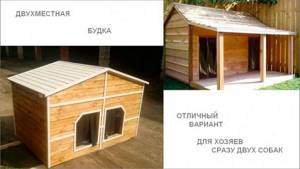
A kennel for two dogs provides two sleeping compartments isolated from each other, located under one roof. Dog kennels for two are most often made one-story, with manholes located next to each other.
A double dog house is an oblong structure with separate entrances. The internal space is divided by a solid wooden partition. A common terrace or vestibule can be attached to such a kennel. In general, the structure of a kennel for two is the same as for one dog.
Before building a dog house with a partition, you need to draw a design diagram taking into account the size of the animals. Usually they make a double kennel with compartments of equal area. If the dimensions of four-legged pets are very different, you can make sleeping places of different sizes.
Step-by-step description of the workflow
Now let's figure out how to organize the work and what you need to have on hand. I will tell you about a simple option that can be implemented in literally an hour if you have experience, and in a couple of hours if you are a beginner and do everything slowly. Let's start our consideration with preparatory activities, since without them it is unlikely that it will be possible to cope with the work.
Collecting everything you need for work
First you need to collect all the materials, we will use the following set:
Installation location
Regardless of the breed, the pet needs to choose a place on the estate, from where the house, gates, and most of the yard will be visible. The guard needs to see the protected area.
The dog's house should not be located in the wind, in the open sun, the entrance should not be flooded with rain or covered with snow. Buildings for animals or birds should not be placed nearby - dogs are sensitive to odors.
The pet should like the chosen place. If he likes to lie down, climbing higher, they arrange a dwelling with a flat roof and place it on a hill.
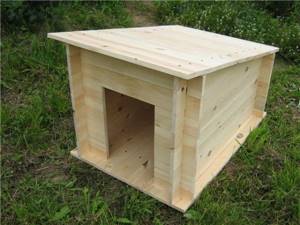
Why you can't keep a dog in a barn
Often, having outbuildings on the property, the owner of the dog prefers not to build a separate house for it, but keeps it in a barn.
This is strictly contraindicated:
- the darkness of the barn constantly keeps the dog in an alert state and is very poorly tolerated by the animal
- a constant reaction to sounds made by insects or rodents causes irritation, nervousness, and anxiety in animals
- the heat generated by the dog’s body will completely heat a small structure, but not a barn
- from the barn it is impossible to observe what is happening outside, this causes depression in the dog, lethargy, and heart disease
- lighting a barn with electricity does not replace daylight and has a bad effect on vision
- It is absolutely unacceptable to keep dogs together with farm animals and poultry.
Can heaters be used?
Many breeders, faced with the need to insulate a dog’s home, are interested in the issue of heating the kennel. Heating can be provided if desired; moreover, you can even lay a heated mat on the floor. Of course, a heated mat or heated booth will be the best option, as no insulation can compare with this. Moreover, heating the home will help ensure dryness inside.
Today you can find several types of heaters on sale:

I recommend: Aseptic resorptive fever - how to treat it in dogs
Size
Let's look at how to decide on the size of the booth based on the fact that your pet has already grown:
- to determine the width of the structure, you need to measure the dog in height to the tips of the ears and add 5 cm;
- the depth of the structure is the length of the dog from the tail to the tip of the nose with an addition of 5 cm;
- To properly arrange the hole, measure the dog at the withers and add 5 cm.
If you got a puppy who will live on the street from the first days, you should refer to the table below, which gives reference sizes of kennels for dogs of different breeds:
| Dog size | Width mm | Length mm | Height mm |
| Large breeds | 1200 | 1000 | 1000 |
| Medium dogs | 1000 | 800 | 1000 |
| Small pets | 800 | 600 | 800 |
Attention! The dog house should be of such a size that the pet can sleep and relax comfortably in it at any time of the year. You should not make a structure that is too large, as the dog will freeze in it in winter.
It is better to make the entrance to the structure closer to the corner, so the dog will have a small closed nook.
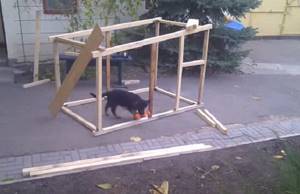
Does it freeze in winter?
Most dogs can comfortably withstand the cold and even sleep in the snow, it all depends on the breed of the dog. Hunting breeds tolerate cold well; by winter they grow thick fur and, in principle, it is not advisable to keep them indoors, as this spoils their innate sense of smell. However, even representatives of the same breed react differently to cold depending on the conditions in which they live.
When a dog lives in an apartment, it sheds more often, since it does not need undercoat in the apartment. When an animal lives in a booth, by winter it grows a warm undercoat, which ensures the preservation of heat.
In addition to the undercoat, the size of the animal also influences heat retention. Large dog breeds lose heat more slowly than small dog breeds. Pets that lack undercoat or have it underdeveloped need winter clothing.
Drawing and diagram
Before you build a kennel, you need to submit a drawing of it! It is not necessary to draw up a special drawing for the booth, since the design is not complicated. You can simply draw a diagram on a simple sheet of paper and determine the dimensions of the structure on it.
If you want to build a booth with exact dimensions, then a drawing is necessary. To complete the drawing correctly, you need to consider the following nuances:
- the interior space should be spacious enough for the dog to turn around freely. If a kennel is made for a puppy, then you need to understand that he will grow up very soon, so it is better to build a large kennel right away;
- if you plan to build a warm kennel, then it is better to use wood as a material - it is practical, environmentally friendly and is an excellent heat insulator;
- if there are frosty winters in your region of residence, then it is better to prefer a kennel built as a sandwich panel with insulation between the walls;
- if a booth is being built for a large dog, then it is installed inside a special enclosure for a four-legged pet;
- It is also advisable to decide on the shape of the roof when drawing up the drawing. For a large dog, it is better to build a kennel with a pitched roof. Dogs love to lie on it in the summer. A gable roof is suitable for a small booth when you need to increase the usable area of the internal space.
Developing a drawing will help to provide for all the nuances of construction and the kennel for your four-legged friend will turn out to be of high quality and comfortable.
Tools
Before you start building the structure, you should prepare the necessary tools:
- screwdriver;
- hacksaw;
- hammer;
- marker;
- ruler or tape measure;
- plane - if unplaned material was purchased;
- metal scissors.
Also, before starting work, prepare the material:
- fasteners - screws, nails;
- bars, boards, lining;
- roofing material;
- insulation;
- plywood or chipboard;
- impregnation to protect wood from external influences.
Important! All boards and beams should be sanded before building the kennel so that the dog does not get hurt. Only the outer walls of the structure are treated with impregnation, otherwise there will be an unpleasant smell in the booth, which the dog may not like.
You also need to take care of the thermal insulation material before starting assembly, and choose the best option in terms of environmental friendliness, practicality and affordability.
Protective and warming dog clothing
If we are talking about representatives of decorative breeds, short-haired dogs, then keeping them on the street is contraindicated for them. To prevent your dog from catching a cold while walking, it must be dressed.
Waterproof overalls are worn if there is slush or wet snow outside. A multi-layer quilted winter blanket for dogs is good because it leaves the paws open without restricting the dog’s movement. In stores you can also find winter boots for dogs and stockings that cover their paws up to their shoulders. They should be made of non-slip fabric and not squeeze the dog's paws.
Clothes will protect the dog from the cold, and shoes will protect them from dirt, salt and chemicals that are sprinkled on the streets in winter. If a dog walks without shoes, then the paw pads must be washed and lubricated with fat to avoid drying out the skin and causing cracks. The walk should be interrupted if the dog is trembling or cowering into a ball - these are signs of hypothermia. You can read more about clothing for dogs here.
Material
The material deserves special attention, because its choice will determine how comfortable the dog will be. We recommend building the kennel out of wood. For the construction of the structure, you should prefer larch or pine wood. Pine material, if properly processed, lasts up to 13 years. Larch lasts much longer, but is also more expensive. Which of these two breeds is preferred depends on the financial capabilities and preferences of the owner.

As for roofing material, it is better to give preference to natural materials, such as tiles.
Floor
The floor in the kennel must be made of warm materials; it is unacceptable to build concrete, stone or brick flooring if you do not plan to install a heated floor system to warm the kennel. The best option would be dry, planed boards, fitted to each other. When laying the floor, it is advisable to make a technological slope to simplify cleaning in the kennel.
Walls
The walls in the booth should not be blown through, so it is better to use plywood for interior decoration. The ideal option would be walls made of the sandwich panel type; it is worth choosing the right insulation material, otherwise there is a high probability that rodents and parasites may live in it. The entrance to the structure is covered with thick fabric in the winter.

To prevent your pet's kennel from breaking down prematurely - the wood rots in a humid environment - consider a good system for removing moisture from the structure. Do not treat wood with impregnations that help repel moisture - this will have a detrimental effect on the dog’s health.
Roof
Which roof to install on the booth: single or gable, depends on the preferences of the owner. We will analyze the pros and cons of each option.

Simple lean-to
Dogs love to spend time in a kennel, especially during warm periods, so a kennel with a pitched roof is most preferable. The roof should be made with a minimum slope. It is advisable that it be on hinges - this will allow you to clean it without much effort and disinfect the structure if necessary. Even at the construction stage, you need to insulate the booth to protect the dog from the winter cold.
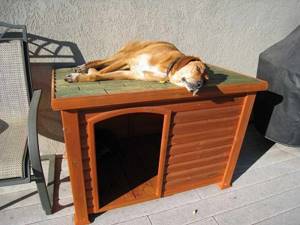
Let's look at step-by-step instructions with photos on how to build such a kennel yourself:
- Construction of the flooring To create the flooring, you need to take a 4x4 cm block, cut two elements in length and 2 in width. Lay the bars on a flat surface and use self-tapping screws and corners to build a frame. For greater strength, install crossbars made of timber of the same size. Sew boards onto the frame on one side.
- Assembling the frame of the booth For the frame you will need 4 bars 5x5 cm. Two bars should be equal to the height of the structure, and the second two should be 10 cm higher. Sections of bars are installed in the corners of the bottom and secured with self-tapping screws. There will be long posts in the front of the booth, short ones in the back. Check all bars for level. To strengthen the structure, additional elements are installed in the center of each wall, and in the place where the opening is arranged, two parallel bars are placed at the required distance from each other, equal to the width of the entrance.
- Sheathing the walls As soon as the frame is ready, the front side is sheathed with a rail car. The interior of the structure is covered with plywood or chipboard. The inner lining is attached with self-tapping screws, and the caps must be recessed into the plywood by 1-2 mm, otherwise the pet may be injured.
- Making the roof For the roof, 4x4 cm bars and OSB are used. The components are used to assemble a frame, which is equal in size to the inner perimeter of the kennel. OSB is cut out and sewn onto the inside of the flooring. The roof is insulated. Then a sheet of material is cut to the outer size and the roof structure is sewn up. It is worth remembering that the top OSB sheet should protrude beyond the booth - 10 cm from the sides, 25 cm from the front. The roof is hinged on one side, and roofing material is laid on top.
- Finishing The booth is almost ready, all that remains is finishing. To do this, the bottom of the booth needs to be covered with roofing felt with a bend on the walls to prevent getting wet and rotting. Treat external walls with antiseptic. Using platbands, line the opening.
- Installing the kennel Once the structure is ready, you should install it in a previously prepared place. To do this, choose a flat hill near the house and with a good view.
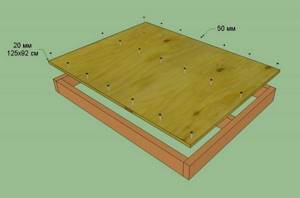
Floor construction
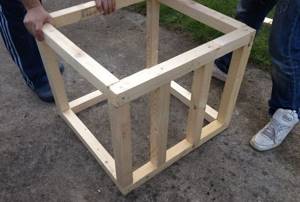
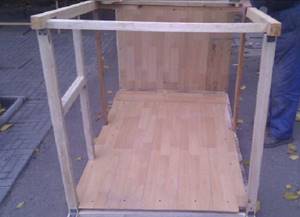

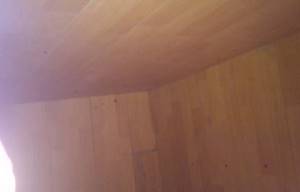
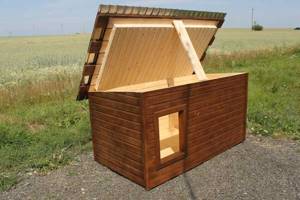
Interesting! Booths with a pitched roof are much simpler in design and lighter in weight, but the useful space in them is less than that of similar structures with a roof on two sides.
Gable
If you are planning a small booth, then you simply need to install a gable roof. The disadvantage of such designs is that they have a high specific gravity - dragging and lifting such booths is very problematic when cleaning.
Step-by-step instructions on how to make a gable house:
- Frame For the frame you need to take 4 50x50 mm bars and build a bottom frame. Install racks made of bars of the same section in the corners. Place a harness on top of the posts. To strengthen the structure, install crossbars on all sides and along the bottom. Install the bars along which the hole will be formed.
- Roof In this case, you need to construct two frames that are connected to each other at an angle of 40 degrees - the roof slopes. Place the workpiece on the frame for temporary fastening. Connect the upper part of the blanks with a ridge block. Install the rafter system.
- Frame cladding For external cladding, lining is used; it is worth making sure that there are no cracks or gaps between the slats. The bottom is sewn up with a board and waterproofing is installed.
- Arrangement of the roof The frame, which was temporarily fixed, is removed. The inside of the roof is covered with plywood. Roofing material is stuffed on top.


Rafter system - marking and installation
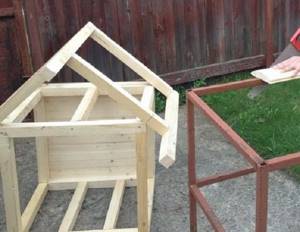
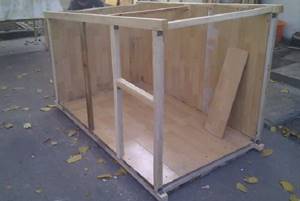
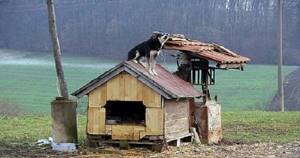
Heated booth
It has recently become popular among dog owners to install an electric heated floor system in their winter kennel. In this case, the dog will not freeze even in severe frost. He will spend a lot of time inside such a booth, so you don’t have to be afraid that in severe frost the dog will settle down for the night under the doors on a snow-covered threshold.
There are several options for creating such heating:
- cable;
- special ready-made rugs;
- infrared mats.
The most effective material will be the use of infrared mats. In addition to heated floors, you can buy a thermostat. This will save the amount of electricity spent on heating. The booth will also have a comfortable temperature.
The danger of using a heated floor in a kennel lies in the animal’s body’s reaction to heat. The fact is that due to such heating, the undercoat will become smaller. If a dog spends a lot of time in the cold and does not have the opportunity to warm up in a kennel, it may get sick.
Therefore, you need to set the heating temperature to the minimum value. The temperature in the booth will be above zero, but you should not allow the air to warm up to +18°C or higher. It is enough that the temperature in the booth is kept at +5...+10°C. The dog will not feel severe discomfort due to the sharp temperature difference inside and outside the kennel.
Instructions for insulating the booth
The kennel should be placed on stands made of bricks or blocks. At the installation site, it is advisable to build an air gap by making a 20 cm depression and filling it with expanded clay or gravel. Cover the hole from above using roofing material or polyethylene. If the booth is insulated from the outside, hem a layer of insulation under the insulation.
The choice of insulation option for a doghouse is determined by the design and size of the structure. A house that can be disassembled can be insulated inside or outside; not dismountable, it is more convenient to insulate from the outside. If the kennel is small and after insulation the dog will feel cramped in it, insulation should be carried out from the outside.
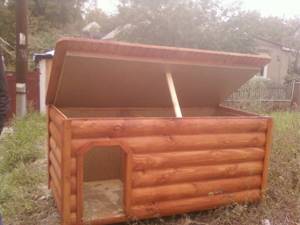
If possible, it is worth making a building with a removable roof and double walls. In the pier, using wooden blocks, a frame is constructed, in which pieces of foam plastic are laid. In the spring you can remove the insulation from the frame.

If you need to insulate a finished house, it is better to carry out the work from the outside. Before insulating a dog house for the winter, it should be cleaned and any cracks sealed.

Turn it upside down and treat the surfaces with an antiseptic. Then cover the bottom with a layer of roofing material, attaching it with wooden slats. You can use a sheet of extruded polystyrene foam 50 mm thick.
Turn the structure over and cover the floor on the inside with roofing felt or other waterproofing material, laying it overlapping. Make a sheathing from the bars. Then lay insulation (mineral wool, polystyrene foam, penofol). The foam is cut 3-5 cm larger than the prepared cells so that it fits more tightly.
- Cover the top with boards, plywood, OSB boards.
- Treat internal surfaces with antiseptic impregnation. Lay a layer of waterproofing material, then a layer of insulation. Cover the top with an insulating layer.
- The ceiling is insulated in the same way as the walls, except for the top layer of insulation, which is not necessary.
- If the walls are covered with plywood, it is worth nailing slats around the perimeter to prevent deformation.
- All nails must be well nailed, and the elements and materials of the booth must be securely fastened.
- To decide how to carry out the work, you can watch a video of insulating a dog house.
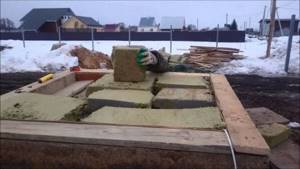
DIY insulated dog house
If we talk about drawings, the animal doesn’t need any “bells and whistles” and the sizes are too large either. For them, this is a hole, and by definition it cannot be large, and it is difficult to heat the extra volume in winter. The booth was made with two windproof walls and a small canopy.
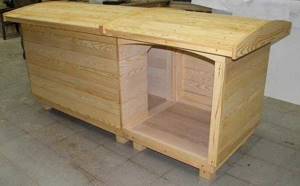
Ready-made dog house
First, we made two pallets to size with supports on four square beams, then connected them together. The result was a podium onto which the floor boards were secured. Legs in the design are desirable - the floor will not get wet.

Finished floor for the booth
The bars were secured in the corners. At the junction there were six pieces: four for the kennel itself, two in front for the windproof walls. First, we made the inner lining, to which 7 cm of penoplex was secured, then we sheathed the outside. To prevent water from flowing into the walls between the boards, the gap was closed from above with a plank of suitable width.
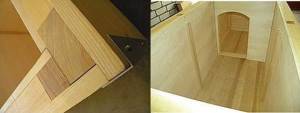
Walls in the booth with insulation
For the outer cladding of the wall to which the windproof wall adjoins, whole boards were used - this makes the structure more rigid.

Manhole and insulated removable roof
We spent the longest time fiddling with the roof. I didn’t want to make it completely flat, so I made an insulated shield strictly to size, which was attached to a slightly rounded roof made from stacked slats. At least it turned out without a slope, but due to the sloping shape, the water drains without problems. Since it was still not possible to make it hermetically sealed, film was placed under the slats.
Insulation materials
Wood shavings, foam plastic, felt or mineral wool are used as insulating materials. Each of these materials has its own characteristics. Wood shavings are difficult to attach to walls and ceilings, but they make good bedding for a dog’s kennel for the winter, soft and environmentally friendly. It should be remembered that parasites often grow in shavings, and if moisture gets in they can even rot. It is better to add shavings of coniferous trees, the smell of which insects do not like. The bedding will have to be replaced regularly, but it is still better than fabric, which the dog can chew or pull out of the kennel. But sawdust is something that should not be placed in a dog’s kennel in winter, as it gets into the nose and eyes, causing inflammation. The prickly dust prevents the dog from lying down properly in the kennel.
Hay
Hay is the easiest thing to put in your dog’s kennel for the winter. The armful of hay on the floor is easily replaced, and this will have to be done about once a week, since hay is also susceptible to rotting. It has a pleasant smell; you can also add dried herbs to it that will repel parasites - thyme, sage or wormwood. From time to time the bedding made of straw or hay is shaken to prevent caking.
If the kennel has double board walls, then shavings or straw are poured into the spaces between them. If the question arises of how to insulate a dog house for the winter and then return to the summer option, then this is the right solution. But in this case, fleas can overwinter with the dog.
Styrofoam
Polystyrene foam and similar foam plastic are used quite often as insulation. Polystyrene foam does not harbor parasites and mold, and is not of interest to rodents. A sandwich package made of two layers of plywood and polystyrene foam between them is used in factory-made booths. However, insulating a dog house for the winter using foam plastic cannot be called environmentally friendly. This material tolerates low temperatures well, but when heated it releases a number of toxic substances. It also deteriorates when exposed to sunlight and outdoors, and burns well.
Penoplex
The principle of laying penoplex is the same as with polystyrene foam. It can either be glued to the walls of the booth, or fixed with screws. It is better to cover the thermal insulation layer with OSB boards, plywood or clapboard - both inside and outside.
Felt
You can upholster the inside of the booth with felt. It can also be useful for curtains at the entrance if you place a felt sheet between two strips of tarpaulin. Its sheets are easy to cut; edges do not need to be processed. This type of insulation is not covered with sheets of plywood. You can cover the outside of the booth with a tarpaulin to protect it from precipitation. It will be difficult for the dog to tear it off or chew it.
Mineral wool
Mineral wool is valued for its durability and good thermal insulation qualities, but it deteriorates when exposed to moisture and shrinks over time. Mineral wool is insulated with thermal film also because it is extremely undesirable for its particles to enter the dog’s respiratory tract. The film is covered with boards on top.
How to insulate a doghouse for the winter
To reduce heat loss, the dog house must be insulated both from the inside and the outside. When choosing thermal insulation materials, preference should be given to those that meet the following requirements:
- low degree of thermal conductivity;
- absence of toxic substances;
- fire resistance;
- not attractive to harmful insects, rodents, pathogenic microorganisms;
- long service life;
- ease of use.
How to insulate a dog's kennel for the winter from the inside
For internal insulation of the doghouse, not only for an adult shepherd dog, but also for other dogs:
- Sheet felt. It is made from sheep wool and is a material unique in its thermal insulation properties. Excellent air permeability, does not burn, has a low level of thermal conductivity, and is relatively light in weight. In addition, it does not absorb moisture and is able to retain its shape. Felt is not afraid of either fungi or mold. Thanks to its roll form, this material is convenient to use. As an option, technical felt would also be appropriate here; its advantage is its affordable cost.
- Mineral wool. This fibrous material, created artificially, has thermal insulation characteristics sufficient to insulate the booth. It can be compared to foam plastic. Advantages: high fire resistance, not susceptible to rodents. The only thing that needs to be taken into account when using it is the presence of fine glass in the composition. To prevent it from entering the pet’s respiratory system, you need to take care of high-quality surface finishing on both sides. It is also worth considering that this material requires careful handling during installation and the use of protective equipment in the form of gloves, overalls, goggles and a respirator.
- Foam sheets. There is a molded type of material, which is characterized by fragility, flammability, and moisture absorption. It should be laid in the cavity and protected with waterproofing. For reliability, it is recommended to sew the foam with sheets of plywood and boards. The second type of foam is extruded polystyrene foam (penoplex), which is distinguished by its strength, moisture resistance, sufficient density, and inflammability. Due to the low degree of thermal conductivity, this material retains heat well indoors.
- Expanded polystyrene. This heat insulator can be effectively used to insulate large-sized booths. All you have to do is remove the roof and lay down the material. It is presented on the market in the form of solid plates with low weight. Thanks to their convenient sizes, they do not greatly reduce space.
- Foamed polyethylene. Two-layer insulation with foil has a thickness of 2-10 mm, its reflection coefficient is from 90%. Compared to analogues, this heat insulator is distinguished by its ability to reflect thermal radiation rather than accumulate it. Among its advantages: moisture resistance, non-flammability, ease of use, resistance to negative environmental factors. It can be used both from the inside and from the outside, but with subsequent finishing.
- Hay. This is the easiest way to insulate a booth from the inside. It is placed in a cover, under which felt is placed.
- Wood shavings. It should be treated with flea control before being placed in a kennel.
How to insulate a dog's kennel outside for the winter
For external insulation, you can use sheets of foam plastic, mineral wool, and penoplex, the main thing is to do the finishing. For these purposes, it is good to use boards, OSB boards, and plywood.
Additional heating
If insulation is not enough, you can equip the booth with heated floors or a heater.
- The panel heater is a safe-to-use device with a thickness of 20 mm and a metal body. The surface heats up to 45-50 degrees Celsius. The advantages of a panel heater are: silent operation, spacious installation, resistance to humidity and economical energy consumption.
- Warm floor. To construct a heated floor, a heating wire is installed and connected to the power supply. This is best done during the construction stage of the booth. A box is constructed from pieces of plywood according to the size of the floor, and bars are nailed along the edges. The heating cable is connected to the thermostat. An electrical cable is connected to the other side. All cracks are carefully sealed. The heating cable is secured through the holes in the base of the box. A hole is made in the base for the wire. Sand is poured into the box and the lid is nailed.
- A film heater is a thin film that emits infrared waves. It distributes heat evenly, is economical and does not heat up. Due to the fact that the length of the waves emitted by the heater and the length of the waves emitted by the dog coincide, the heater has a positive effect on the health and immunity of the animal.
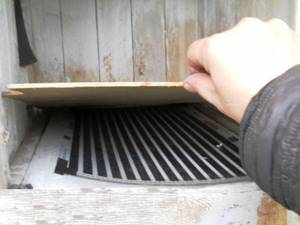
Brick or block booth
Brick or block construction is not the most popular option due to the high cost of the material. But in strength and durability it surpasses all other types. Such a structure can be used for decades and become a shelter for more than one generation of dogs.
The construction of a booth made of brick or block materials is similar to a permanent house, albeit in small quantities, and includes the following steps:
- Clearing, leveling and marking the site.
- Preparing a 15x30 cm trench around the perimeter.
- Laying reinforcement bars.
- Preparation of concrete and pouring into the pit.
- Strengthening takes 3-5 days.
- Laying half-brick walls with bandaging of seams and corners.
- Installation of a lintel over a hole from metal corners or oak boards. If you have enough skill, you can lay out the opening in the form of an arch without using lintels.
- Installation of rafters and sheathing.
- Laying waterproofing, roofing. You can make a separate lid with a lifting mechanism to facilitate changing the litter and cleaning.
Brick, gas or foam concrete retain heat perfectly, but additional internal insulation will not be superfluous for the dog’s winter residence. Exterior decoration in accordance with the general style of the estate will give the building a complete look and emphasize its solidity and solidity.
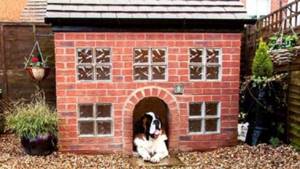
Making a regular warm booth
To make a booth from wooden beams and boards, you need to master the “hammer and nail” to a greater extent than in previous versions.
When making a good quality, well-insulated booth, the principle is still the same. The frame and internal upholstery are fixed to a solid solid base. Then the insulation is laid and the top is covered with exterior finishing. The roof should be sloping, possibly gable.
It is recommended to provide a removable flat roof for easy maintenance of the booth. Many dogs prefer to spend more time on the flat roof of their kennel than inside...
An example of a design (very simple) with dimensions is shown in the figure. The thickness of the beams must be selected according to the thickness of the insulation so that it is pressed tightly against the seal on the inner upholstery and there is no air blowing in this place. It is advisable to tighten the insulation to the interior trim with screws and washers.
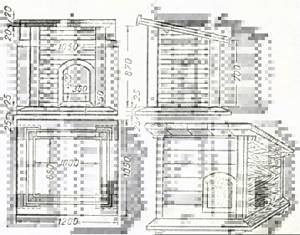
- The base is a board made of boards 30 - 40 mm thick, then extruded polystyrene foam 35 mm thick is laid spaced against the sidewalls, then a layer of foamed polyethylene to eliminate cracks, and a 10 mm thick tongue-and-groove lining flooring is placed on top.
- The walls contain timber for the frame, 35 mm thick polystyrene foam on a 3 mm polyethylene foam backing (for tightness), tongue-and-groove paneling on the inside and outside.
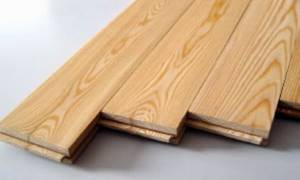
There is no insulation in the corners - cold bridges, but this is not critical for the kennel; what is more important is ensuring tightness in all corners. - The roof is a double wooden panel made of 10 mm boards, between which there is 20 mm extruded polystyrene foam and polyethylene foam. The boards in layers are arranged mutually perpendicular, tightened with screws 40 mm long.
- The roof is supported along the perimeter by a soft upholstery of felt and polyethylene foam to ensure tight sealed contact with the walls. But it is important that the dog cannot tear off the pliable material. The top of the roof is covered with a roofing covering, fused with roofing felt, for example.
It is recommended to make such a wonderful insulated booth for a dog. The dimensions of the booth are according to the size of the dog. Insulated dog kennel size recommendations are below. Internal dimensions are given.
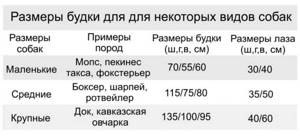
Booth entrance protection
For additional protection of a kennel that does not have a vestibule, a curtain is hung at the entrance. It can be made from tarpaulin or felt. Cut two pieces of fabric to fit the opening, adding 5 cm on all sides.
Fold both pieces in half, with the ends to the sides of the hole, and attach them to a wooden batten. It is advisable to attach the pieces with an overlap of about four to five centimeters. Nail the strip with the fabric along the top of the hole.
- On the sides of the hole, nail the curtain to the booth, placing wooden slats on top. To make the curtain heavier, you can sew pockets on the bottom and pour sand into them or insert steel rods.
- You can also attach the curtain from the outside, securing it at the top and sides using slats.
- For curtains, you can use ready-made silicone blinds with a thickness of 0.5-1 cm. Blinds are less susceptible to contamination, but they protect less well from the cold.
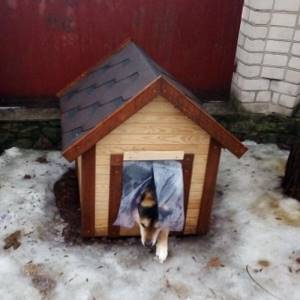
Barrel booth
Another option for a simple and quick-to-make home for a dog is a booth made from a disused barrel. Wooden, metal or plastic containers are suitable, except for those where fuel oil, toxic or strong-smelling substances were stored.
The barrel must be placed on its side and supported on all sides on strong stands. A hole is cut in the lid (if available). Instead, you can make a panel from boards or thick plywood and attach it to the ends of the container. The interior space is insulated with any available material.
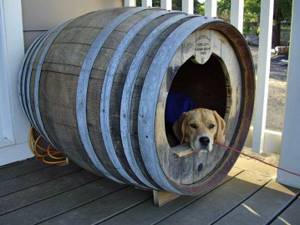
Which bedding is better
In the previous paragraph we looked at the three most common types of dog beds, but you need to remember that there are as many opinions as there are people. In particular, there are dog owners who prefer to use polystyrene foam, padding polyester and other artificial materials. Regarding foam plastic, for example, you can lay it on the bottom of the booth and cover it with plywood on top.
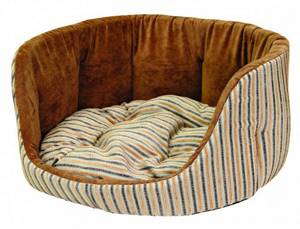
When choosing bedding material, you need to look at the dog’s reaction to all of the above types of litter, since the dog may reject any of them, but will feel comfortable with another type of bedding. Having settled on some material, do not forget to update it from time to time, which will protect your pet from diseases, fleas and other negative factors.
Floor insulation

The norms and rules for insulating a kennel, regardless of the material, are summarized. It is important to lay the insulation so that on the inside and outside of the dog house the animal does not have access to it. The only exception can be that material that has specific installation rules. But, before working on the main part, it is important for the owner to focus on the floor - be sure to caulk the cracks and choose a good bedding option. For example, you can use wood shavings. Basic recommendations for preparing such material:
- Wood shavings must be chosen in a large fraction - sawdust is dangerous for the animal, as it can get into the eyes, nose and ears.
- The best wood for this purpose is coniferous; it repels most pests.
- Treatment against ticks and replacement at least once a month is mandatory.
- If you cover the shavings with cloth, then you need to choose a durable cloth and fix it inside the kennel.

Attention!
Be sure to sift the shavings before use - no small particles should remain. If sawdust gets on the mucous membranes, an inflammatory process may begin.
Insulating a dog kennel is not a difficult task. Suitable materials for this are quite cheap, and their quantity is not large. But, when choosing insulation, you need to carefully inspect it for safety for your pet, so as not to harm its health, saving it from the cold. Additional heating is also possible, but in severe frosts it is better to simply take the dog into your house.
Curtain installation
After the booth is completely insulated, you need to equip it with a curtain that will maintain the optimal temperature inside. Suitable fabrics for making curtains:
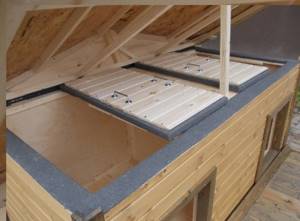
- Tarpaulin. This material is highly durable. During production, its base is treated with a special compound that prevents fire. A distinctive feature of this fabric is its elasticity, so the curtain can be easily adjusted according to the size of the entrance itself.
- Felt fabric. It is made on an artificial basis, so it perfectly retains heat inside the kennel. Felt can be easily cut into the required pieces, and there is no fear that the edges of the material will begin to crumble or tear.
When making a fabric door, it is worth considering that it should completely block the entrance, but not disturb the pet. It is advisable to first mark out the required dimensions and only then cut the fabric. It is best to make small allowances of 5 cm on the side and 10 cm at the bottom. It is best to fasten the fabric using a wooden plank and self-tapping screws, then the dog will not be able to accidentally tear it off.
Thermal insulation of an old booth
First, the old booth must be washed and disinfected using products recommended by veterinary services that are not harmful to the health of the animal. Having thoroughly dried the room, insulation and exterior finishing are carried out on top of its facades.
Technoplex 1 cm thick is laid on the base of boards (plywood), polyethylene foam 3 mm thick to eliminate cracks, and on top is an old booth, pressed into the polyethylene with screws, nails, and corners. The booth needs to be upholstered on the sides and top with foamed polyethylene 5-10 mm thick, covered with clapboard walls and a roof with roofing material.
Photos of beautiful
If the site is designed in accordance with the rules of landscape design, then a simple dog house made from boards may not fit into the overall look. By building a structure with your own hands, you can turn on the artist’s imagination and decorate a house for your four-legged friend. To do this, you can use both improvised materials and wood carvings.
Sources
- https://moypitomec.ru/sobaki/soderzhanie-i-uxod-sobaki/sobachja-budka-svoimi-rukami-chertezhi.html
- https://TeploRes.ru/montazh-i-remont/kak-obogret-sobachyu-budku.html
- https://eco-kotly.ru/uteplenie-budki-dla-sobaki-kak-mozno-uteplit-budku-dla-sobaki-na-zimu/
- https://sobakus.com/svoimi-rukami/budka.html
- https://stroitelstvo.expert/kak-uteplit-budku-dlya-sobaki-na-zimu/
- https://aploks.ru/byt-sobak/uhod-i-soderzhanie/kakimi-materialami-i-kak-uteplit-budku-dlya-sobaki-na-zimu.html
- https://ProUteplenie.com/otoplenie/kak-uteplit-budku-dlya-sobaki-na-zimu-poshagovaya-instruktsiya
- https://aniko-gas.ru/montazh/zimnyaya-budka-dlya-sobaki.html
- https://ogorod-bez-hlopot.ru/kak-uteplit-budku-dlya-sobaki.html
[collapse]
